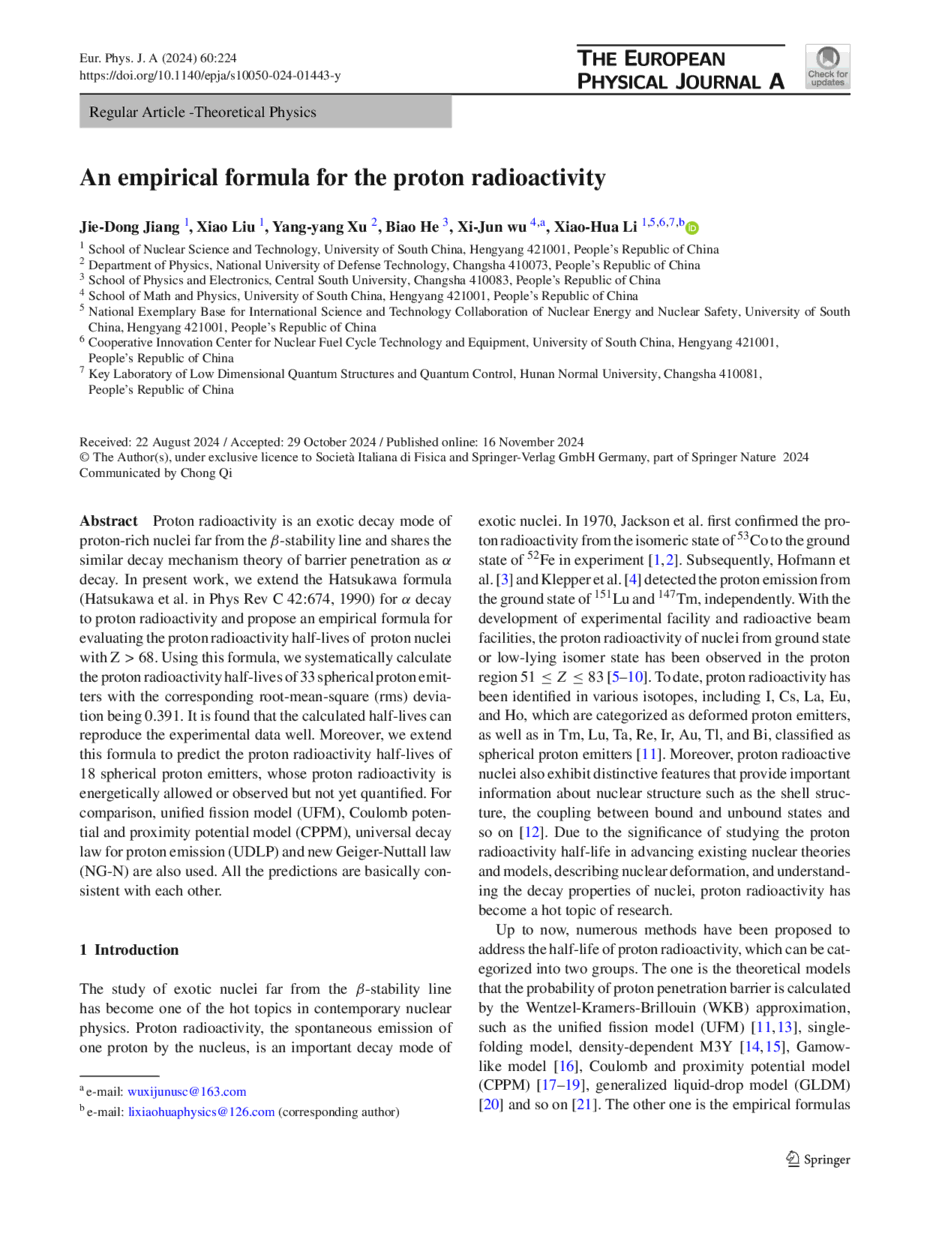https://doi.org/10.1140/epja/s10050-024-01443-y
Regular Article –Theoretical Physics
An empirical formula for the proton radioactivity
1
School of Nuclear Science and Technology, University of South China, 421001, Hengyang, People’s Republic of China
2
Department of Physics, National University of Defense Technology, 410073, Changsha, People’s Republic of China
3
School of Physics and Electronics, Central South University, 410083, Changsha, People’s Republic of China
4
School of Math and Physics, University of South China, 421001, Hengyang, People’s Republic of China
5
National Exemplary Base for International Science and Technology Collaboration of Nuclear Energy and Nuclear Safety, University of South China, 421001, Hengyang, People’s Republic of China
6
Cooperative Innovation Center for Nuclear Fuel Cycle Technology and Equipment, University of South China, 421001, Hengyang, People’s Republic of China
7
Key Laboratory of Low Dimensional Quantum Structures and Quantum Control, Hunan Normal University, 410081, Changsha, People’s Republic of China
Received:
22
August
2024
Accepted:
29
October
2024
Published online:
16
November
2024
Proton radioactivity is an exotic decay mode of proton-rich nuclei far from the  -stability line and shares the similar decay mechanism theory of barrier penetration as
-stability line and shares the similar decay mechanism theory of barrier penetration as  decay. In present work, we extend the Hatsukawa formula (Hatsukawa et al. in Phys Rev C 42:674, 1990) for
decay. In present work, we extend the Hatsukawa formula (Hatsukawa et al. in Phys Rev C 42:674, 1990) for  decay to proton radioactivity and propose an empirical formula for evaluating the proton radioactivity half-lives of proton nuclei with Z > 68. Using this formula, we systematically calculate the proton radioactivity half-lives of 33 spherical proton emitters with the corresponding root-mean-square (rms) deviation being 0.391. It is found that the calculated half-lives can reproduce the experimental data well. Moreover, we extend this formula to predict the proton radioactivity half-lives of 18 spherical proton emitters, whose proton radioactivity is energetically allowed or observed but not yet quantified. For comparison, unified fission model (UFM), Coulomb potential and proximity potential model (CPPM), universal decay law for proton emission (UDLP) and new Geiger-Nuttall law (NG-N) are also used. All the predictions are basically consistent with each other.
decay to proton radioactivity and propose an empirical formula for evaluating the proton radioactivity half-lives of proton nuclei with Z > 68. Using this formula, we systematically calculate the proton radioactivity half-lives of 33 spherical proton emitters with the corresponding root-mean-square (rms) deviation being 0.391. It is found that the calculated half-lives can reproduce the experimental data well. Moreover, we extend this formula to predict the proton radioactivity half-lives of 18 spherical proton emitters, whose proton radioactivity is energetically allowed or observed but not yet quantified. For comparison, unified fission model (UFM), Coulomb potential and proximity potential model (CPPM), universal decay law for proton emission (UDLP) and new Geiger-Nuttall law (NG-N) are also used. All the predictions are basically consistent with each other.
Copyright comment Springer Nature or its licensor (e.g. a society or other partner) holds exclusive rights to this article under a publishing agreement with the author(s) or other rightsholder(s); author self-archiving of the accepted manuscript version of this article is solely governed by the terms of such publishing agreement and applicable law.
© The Author(s), under exclusive licence to Società Italiana di Fisica and Springer-Verlag GmbH Germany, part of Springer Nature 2024
Springer Nature or its licensor (e.g. a society or other partner) holds exclusive rights to this article under a publishing agreement with the author(s) or other rightsholder(s); author self-archiving of the accepted manuscript version of this article is solely governed by the terms of such publishing agreement and applicable law.





